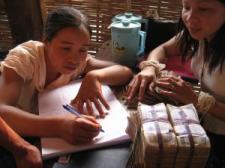Participatory planning, monitoring and evaluation

Ga direct naar: Zoeken | Hoofdmenu | Snelkoppelingen
You are here: Home » KIT Information & Library Services » ILS Information products » PARTICIPATORY PLANNING, MONITORING AND EVALUATION
KIT Dossier Participatory planning, monitoring and evaluation
The History of Participatory Planning, M&E
The value and need for basing development on the views and priorities of ‘the local population’ has become widely acknowledged over the last decades, leading to a practice of working with communities.
Initially pioneered by action research-oriented initiatives and organizations, the use of participatory approaches and methods has become increasingly mainstreamed. The use of tools such as social mapping, Venn diagrams, wealth ranking, and transects has become normal practice in development work, including World Bank-supported CDD programmes. Ministries have started to include participatory methodologies in guidelines provided to local governments for developing municipal development plans, such as in Benin and Mali.
Participatory diagnosis, priority setting, and planning have become an accepted ethic and are practiced in hundreds of Northern and Southern development initiatives. However, ‘participation’ should also address implementation, monitoring and evaluation (M&E). There is a rapidly growing interest in ensuring wider participation, and since the mid 1990s, the term 'Participatory Monitoring & Evaluation' (PM&E) has received increasing attention.
Other trends that underscore the interest in PM&E are:
- frustration with the inadequacy of prevailing M&E systems to capture local knowledge, needs, aspirations and views;
- recognition within development initiatives of the importance of continuous adaptation and innovation to ensure the relevance of the work. In turn, this requires capacity to reflect on own experiences and learn from them;
- pressure for a more diverse approach towards accountability: in addition to upward reporting, also downward accountability towards communities and internal accountability towards staff and peer organizations.
Purposes of PM&E
PM&E is being asked to fulfil a wide range of purposes for different stakeholders - some for citizens, some for service providers, some for government agencies and some for projects, programmes or partnerships.
Alongside the range of purposes that are possible to pursue with more participatory forms of M&E goes its increasing use as a generic term, but also the lack of a common understanding. This makes it imperative to be clear about what is being pursued with PM&E. Is the focus mostly on monitoring (tracking and feedback)? Is it on evaluation (assessing and performance review)? Or is it more on ‘strengthening and deepening participation’ (shared learning, joint decision-making, mutual respect, co-ownership, democratisation and empowerment)?
It is important not to assume that different purposes can automatically be achieved within a single approach or process. Each purpose has different requirements in terms of capacities, information systems, resources and minimal conditions for success. Expecting several or even all purposes to be equally well fulfilled within a short timeframe may prove overly optimistic and lead to disillusion.
Participation, Local Governance and Accountability
Participation is one of the essential elements of the capacity building for decentralization and local governance. Communities, civil society organizations and individuals can play a crucial role in ensuring that local government responds to their needs by participating in the planning, budgeting, implementation and monitoring of activities and projects affecting their lives and eventually impacting the level of human development they maintain.
Participation enhances people’s involvement in decision-making, aiming to influence development initiatives and resources which affect them. Planning, budgeting, monitoring and evaluation are different stages of the development process. Stakeholder participation in these stages may allow more adaptive, flexible approaches, and effective accountability mechanisms.
However, while primary stakeholders are increasingly involved in some aspects of planning, their presence within the budgeting, monitoring and evaluation of actions is all too often lacking or inadequate.
Monitoring and evaluation is about assessing actual change against stated objectives, and making a judgement whether development efforts and investments were worthwhile or ‘cost-effective’. Therefore, monitoring and evaluation systems are generally constructed to provide information for reporting on achievements in order to fulfil accountability responsibilities. This has led to M&E being largely associated with a controlling and accountability function.
Increasingly, however, there is recognition that M&E systems may also contribute to strategic management and learning lessons, and to feeding experiences into policy processes. The PM&E process may also help to clarify rights and responsibilities and, where needed, formulate demands towards other actors and articulate these in the appropriate fora for dialogue and decision-making. PM&E becomes linked to social accountability which refers to a broad range of actions and mechanisms that citizens, communities, independent media, and civil society organizations use to hold public officials and public servants accountable. Social accountability tools include participatory budgeting, public expenditure tracking, citizen report cards, community score cards, social audits, citizen charters, people’s estimates, and so forth. These mechanisms are being increasingly recognized world-wide as a means of enhancing democratic governance, improving service delivery, and creating empowerment (Worldbank, 2007).
Snelkoppelingen
Agenda News Press Working at KIT About KIT Cookies Contact
Nederlands -English




